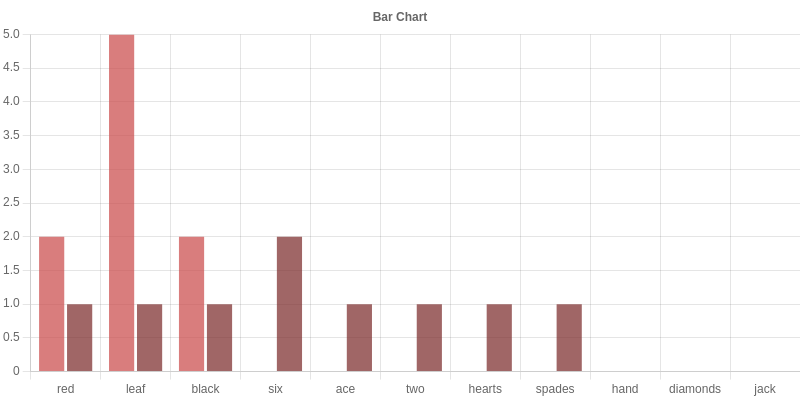Count Constructors
Synopsis
Generic function that can count constructors in a value of any algebraic data type.
Description
In Colored Trees, we have seen a function that can count the number of red nodes in a ColoredTree.
Is it possible to define a function that can count constructors in a value of any algerbaic data type?
We exploit the subtype relation (see Static Typing) between algebraic data typess and the type node to achieve this.
In real applications this becomes relevant when counting, for instance, statement types in programs.
Examples
import Node;
import Map;
data ColoredTree
= leaf(int N)
| red(ColoredTree left, ColoredTree right)
| black(ColoredTree left, ColoredTree right)
;
ColoredTree CT = red(black(leaf(1), red(leaf(2),leaf(3))), black(leaf(3), leaf(4)));
data Suite
= hearts()
| diamonds()
| clubs()
| spades()
;
data Card
= two(Suite s)
| three(Suite s)
| four(Suite s)
| five(Suite s)
| six(Suite s)
| seven(Suite s)
| eight(Suite s)
| nine(Suite s)
| ten(Suite s)
| jack(Suite s)
| queen(Suite s)
| king(Suite s)
| ace(Suite s)
;
data Hand = hand(list[Card] cards);
Hand H = hand([two(hearts()), jack(diamonds()), six(hearts()), ace(spades())]);
// Count frequencies of constructors
map[str,int] count(node N) { ❶
freq = (); ❷
visit(N) { ❸
case node M: {
name = getName(M); ❹
freq[name] ? 0 += 1;
}
}
return freq; ❺
}
map[str,int] countRelevant(node N, set[str] relevant) = domainR(count(N), relevant); ❻
test bool tstCount() = count(CT) == ("red":2, "leaf":5, "black":2);
test bool tstCountRelevant() = countRelevant(CT, {"leaf"}) == ("leaf" : 5);
Two data types are introduced ColoredTree and Hand together
with an example value of each (CT, respectively, H).
❶ The function
countis defined.❷ Introduces an empty map to maintain the frequencies.
❸ Defines a visit of argument
N; it traverses the complete value ofN.❹ Defines the case that we encounter a node and we update its frequency count. First the name of the constructor is retrieved (using getName) and then the frequency is updated. The isDefined operator is used to provide a default value of 0 when the name was not yet in the map.
❺ The map
freqis returned as result.❻ Defines a variant
countRelevant; it gets is an extra argument of relevant constructors names that is used to filter the map that is returned bycountusing domainR.
rascal>count(CT);
map[str, int]: ("red":2,"leaf":5,"black":2)
rascal>count(H);
map[str, int]: ("six":1,"ace":1,"two":1,"hearts":2,"spades":1,"hand":1,"diamonds":1,"jack":1)
rascal>countRelevant(H, {"hearts", "spades"});
map[str, int]: ("hearts":2,"spades":1)
Comparing the two counts visually:
rascal>import vis::Charts;
ok
rascal>import Relation;
ok
rascal>barChart(["CT", "H"], toRel(count(CT)), toRel(count(H)))
